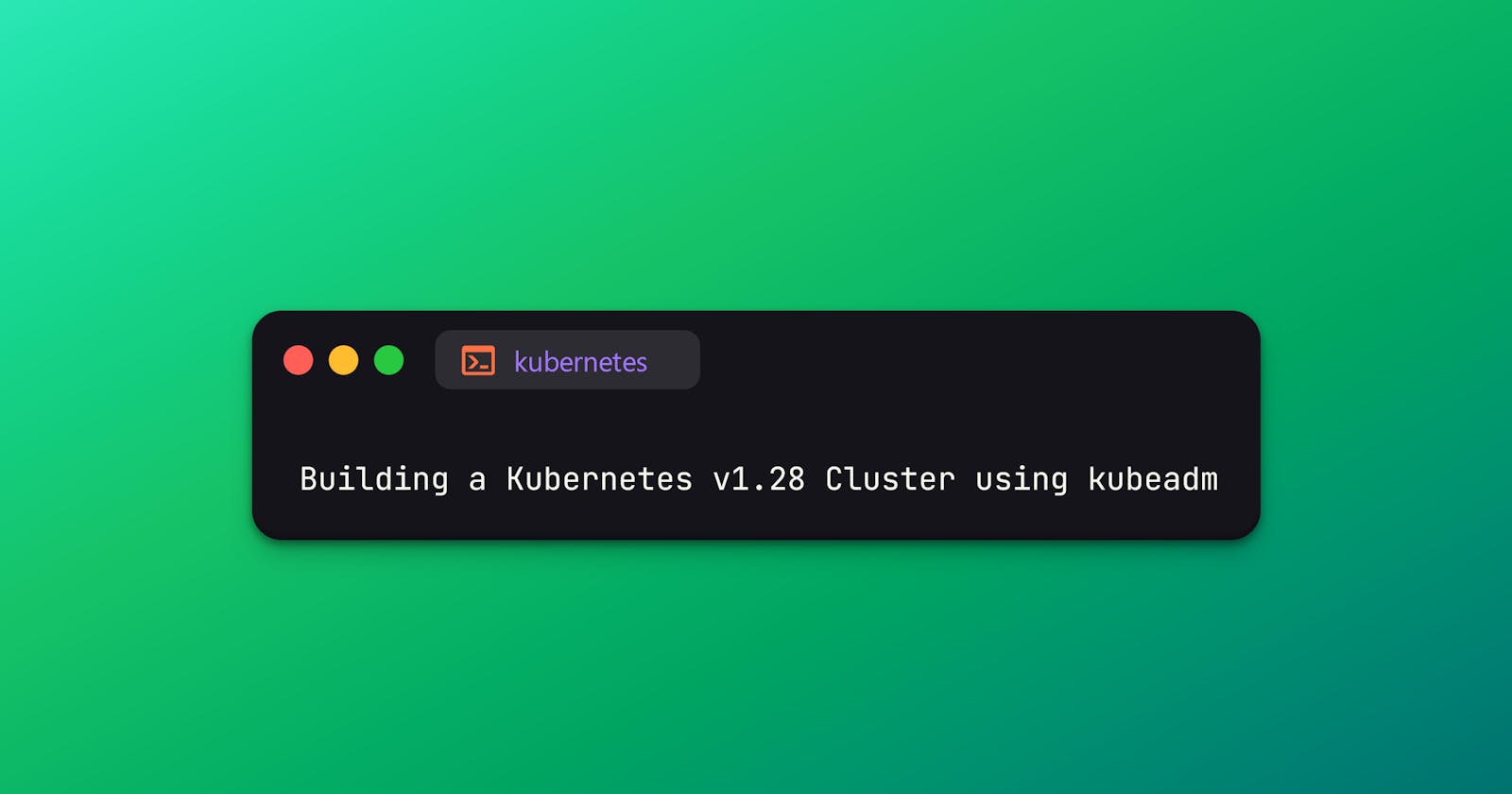Building a Kubernetes v1.28 Cluster using kubeadm
In this article, we will look how we can set up a three node Kubernetes v1.28 cluster using kubeadm
Introduction
kubeadm is a tool used to create Kubernetes clusters
It automates the creation of Kubernetes clusters by bootstrapping the control plane, joining the nodes etc
Follows Kubernetes release cycle
Open-source tool maintained by the Kubernetes community
Prerequisites
Create three Ubuntu 20.04 LTS instances for the control plane, node-1 and node-2
Each instance has a minimum specification of 2 CPU and 2 GB RAM
Networking must be enabled between instances
Required ports must be allowed between instances
Swap must be disabled on instances
Initial Configuration
Set up unique hostnames on the control-plane, node-1 and node-2
Once the hostnames are set, log out from the current session and log back in to reflect the changes
# control-plane
sudo hostnamectl set-hostname control-plane
# node-1
sudo hostnamectl set-hostname node-1
# node-2
sudo hostnamectl set-hostname node-2
Update the hosts file on the control-plane, node-1 and node-2 to enable communication via hostnames
# control-plane, node-1 and node-2
sudo vi /etc/hosts
172.31.91.254 control-plane
172.31.94.177 node-1
172.31.87.11 node-2
Disable swap on control-plane, node-1 and node-2 and if a swap entry is present in the fstab file then comment out the line
# control-plane, node-1 and node-2
sudo swapoff -a
sudo vi /etc/fstab
# comment out swap entry
To set containerd as our container runtime on control-plane, node-1 and node-2, first, we need to load some Kernel modules and modify system settings
# control-plane, node-1 and node-2
cat << EOF | sudo tee /etc/modules-load.d/containerd.conf
overlay
br_netfilter
EOF
sudo modprobe overlay
sudo modprobe br_netfilter
# control-plane, node-1 and node-2
cat << EOF | sudo tee /etc/sysctl.d/99-kubernetes-cri.conf
net.bridge.bridge-nf-call-iptables = 1
net.ipv4.ip_forward = 1
net.bridge.bridge-nf-call-ip6tables = 1
EOF
sudo sysctl --system
Installation
Once the Kernel modules are loaded and the system settings are modified, now we can install containerd runtime on control-plane, node-1 and node-2
# control-plane, node-1 and node-2
sudo apt update
sudo apt install -y containerd
Once the packages are installed, generate a default configuration file for containerd on control-plane, node-1 and node-2 and restart the containerd service
# control-plane, node-1 and node-2
sudo mkdir -p /etc/containerd
sudo containerd config default | sudo tee /etc/containerd/config.toml
sudo systemctl restart containerd
We need to install some prerequisite packages on control-plane, node-1 and node-2 for configuring the Kubernetes package repository
# control-plane, node-1 and node-2
sudo apt update
sudo apt install -y apt-transport-https ca-certificates curl
Download the Google Cloud public signing key and configure Kubernetes apt repository on control-plane, node-1 and node-2
# control-plane, node-1 and node-2
sudo mkdir -p /etc/apt/keyrings
curl -fsSL https://pkgs.k8s.io/core:/stable:/v1.28/deb/Release.key | sudo gpg --dearmor -o /etc/apt/keyrings/kubernetes-apt-keyring.gpg
echo 'deb [signed-by=/etc/apt/keyrings/kubernetes-apt-keyring.gpg] https://pkgs.k8s.io/core:/stable:/v1.28/deb/ /' | sudo tee /etc/apt/sources.list.d/kubernetes.list
Install kubeadm, kubelet and kubectl tools and hold their package version on control-plane, node-1 and node-2
# control-plane, node-1 and node-2
sudo apt update
sudo apt install -y kubeadm=1.28.0-1.1 kubelet=1.28.0-1.1 kubectl=1.28.0-1.1
sudo apt-mark hold kubeadm kubelet kubectl
Initialize the cluster by executing the below command on control-plane
# control-plane
sudo kubeadm init --pod-network-cidr 192.168.0.0/16 --kubernetes-version 1.28.0
Once the installation is completed, set up our access to the cluster on control-plane
# control-plane
mkdir -p $HOME/.kube
sudo cp -i /etc/kubernetes/admin.conf $HOME/.kube/config
sudo chown $(id -u):$(id -g) $HOME/.kube/config
Verify our cluster status by listing the nodes
But our nodes are in a NotReady state because we haven’t set up networking
# control-plane
kubectl get nodes
NAME STATUS ROLES AGE VERSION
control-plane NotReady control-plane 40s v1.28.0
Install the Calico network addon to the cluster and verify the status of the nodes
# control-plane
kubectl apply -f https://raw.githubusercontent.com/projectcalico/calico/v3.26.1/manifests/calico.yaml
# control-plane
kubectl get nodes
NAME STATUS ROLES AGE VERSION
control-plane Ready control-plane 101s v1.28.0
Once the networking is enabled, join our workload nodes to the cluster
Get the join command from the control-plane
# control-plane
kubeadm token create --print-join-command
Once the join command is retrieved from the control-plane, execute them in node-1 and node-2
# node-1 and node-2
sudo kubeadm join 172.31.91.254:6443 --token o3in76.aeqii9shr86cem2w --discovery-token-ca-cert-hash sha256:e301651b8930363842b054bafec26aba718dbc724d903c4c73228703622dc5f1
Verify our cluster and all the nodes will be in a Ready state
# control-plane
kubectl get nodes
NAME STATUS ROLES AGE VERSION
control-plane Ready control-plane 2m55s v1.28.0
node-1 Ready <none> 28s v1.28.0
node-2 Ready <none> 19s v1.28.0
Application Deployment
Deploy an Nginx pod, expose it as ClusterIP and verify its status
# control-plane
kubectl run nginx --image=nginx --port=80 --expose
service/nginx created
pod/nginx created
kubectl get pod nginx -o wide
NAME READY STATUS RESTARTS AGE IP NODE NOMINATED NODE READINESS GATES
nginx 1/1 Running 0 17s 192.168.247.1 node-2 <none> <none>
kubectl get svc nginx
NAME TYPE CLUSTER-IP EXTERNAL-IP PORT(S) AGE
nginx ClusterIP 10.97.157.101 <none> 80/TCP 38s
That's all for now
Reference
https://kubernetes.io/docs/setup/production-environment/tools/kubeadm/install-kubeadm/
